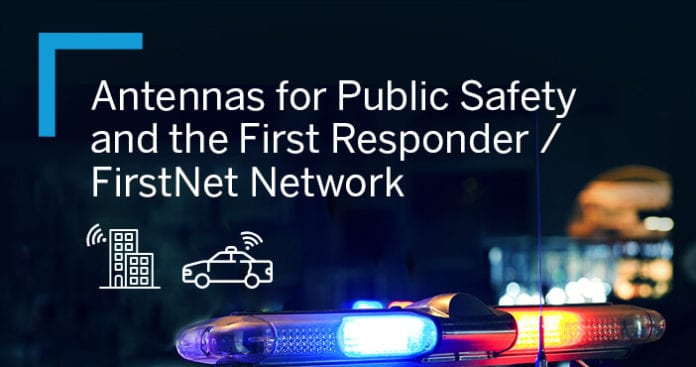Established in 2012, the First Responder Network Authority (FirstNet) is a federal agency created by Congress to oversee the building, deployment and operation of a nationwide public safety broadband network.
Serving as an independent authority within the National Telecommunications and Information Administration (NTIA), FirstNet is governed by a board of federal, private, and public safety representatives that dictate the policies and communication standards for the agency. This wireless network aims to provide first responders, including law enforcement, firefighters, paramedics and other emergency service personnel, with a reliable connection – even in the most difficult of circumstances and environments. Public safety networks are in the midst of a much needed upgrade with the buildout of the National Public Safety Broadband Network (NPSBN) and the first priority use of the LTE Band 14 spectrum. The 4G LTE public safety spectrum utilizes a lower frequency 700MHz band (LTE Band 14) to offer data and in the future, voice over LTE, providing mission critical data/voice communications in a single end user device. Deploying 4G LTE FirstNet in all 50 states comes with many challenges, particularly for locations with interference issues, such as inside buildings. To ensure that the LTE FDD 14 wireless devices deliver the right public safety related features at the right time, special attention to the development and installation of in-building distributed antenna systems (iDAS) is vital.
FirstNet Challenges
There are many hurdles to improve FirstNet and achieve the goal of creating a reliable national public safety network. Responders need dependable communication services, even in rural areas that have little-to-no cellular coverage. This is the responsibility of FirstNet and AT&T to deliver adequate coverage throughout the US. Public safety networks still utilize a wide range of technologies, as each municipality, county, and state selects the network technologies and products to implement. As a result, infrastructure like iDAS must work with all of those technology standards to ensure proper functionality and communication at all time. A few of those technologies include 350-520, 600-960, 1350-1550, and 1690-6000 MHz for UHF, 2G/3G/4G Cellular, UMTS/AWS-3, CBRS, and Wi-Fi frequency bands. As AT&T continues to work with states to upgrade existing networks and implement 4G LTE coverage across the board for first responders, wireless device and technology manufactures must keep up.
Another challenge is that every public safety communication system is controlled by a different local municipality. Meaning each RAN system has its own set of minimum performance requirements – if any local requirements exist at all. This includes minimal signal strength. According to the National Fire Protection Association (NFPA) 1221 (2016) and International Fire Code (IFC) 2018 codes, the recommended minimum signal strength is -95 dBm to satisfy coverage. Emergency radio access networks do not always adequately provide wireless coverage inside buildings. This is why in-building distributed antenna systems are required.
DAS Solutions
Distributed antenna systems, or DAS, is a network of spatially separated antenna nodes connected to a common source via a transport medium that provides wireless service within a geographic area or structure. DAS elevations are generally at or below the clutter level, with compact node installations. Public Safety in-building DAS improve indoor public safety connectivity by bringing UHF/3G/4G/FirstNet radio signals inside buildings to offer improved communications in environments with more interference. Proper antenna selection helps ensure the call quality and connection speeds that users expect in locations such as hospitals, universities, shopping centers, stadiums, and other public venues. High quality iDAS utilize omnidirectional antennas to provide pattern coverage optimized for public safety applications and requirements.
Improving indoor wireless coverage and capacity usually requires deployment of more ceiling antennas. However, this is at the expense of the in-building design and aesthetics required by network operators and sought after by building owners/management firms. Typically, larger volcano antennas offer longer range compared to smaller circular dome and square antennas. However, the size of the antenna can be problematic, particularly in older buildings that may have space constraints. New municipality construction must meet building codes that include 4G LTE FirstNet requirements, as well additional wireless range and performance specifications. Unfortunately, private new construction does not have requirements for in-building DAS capabilities.
New technology developments have enabled manufacturers to design ultra low-profile iDAS antennas. Antennas like the 7.6 millimeters thick CFSA35606P from Laird Connectivity provide buildings with an inconspicuous yet high performance antenna for enhanced wireless connectivity. Ultra low-profile antennas engineered specifically for public safety and FirstNet applications should be designed optimally. The problem is that the traditional serial optimizers take an enormous amount of time to converge to an optimal solution; hence, a less than optimal, but adequate, design is achieved. Laird Connectivity’s proprietary AIO (Artificial Intelligence Optimizer) software addresses this issue so that a true convergent solution is achieved in a fraction of the time. What does this mean to the iDAS network? The AIO software offers significantly more advanced capabilities, compared to conventional software design optimization, to improve wireless range. AIO software is now being used to design antennas for specific FirstNet in-building applications.
Conclusion
Mission critical public safety wireless communications are driven by new applications, interoperability needs, and coverage requirements. Public safety communications are facing a complex convergence of technologies. FirstNet and AT&T are now working to develop a singular public safety LTE network. This network promises to be a dramatic leap in performance over what is being used by emergency responders today. The next wave of public safety communications equipment must support a wide variety of applications, including UHF/3G/4G and more. This includes in-building distributed antenna systems that enable first responder organizations and building owners to meet the requirements of FirstNet public safety communications.

